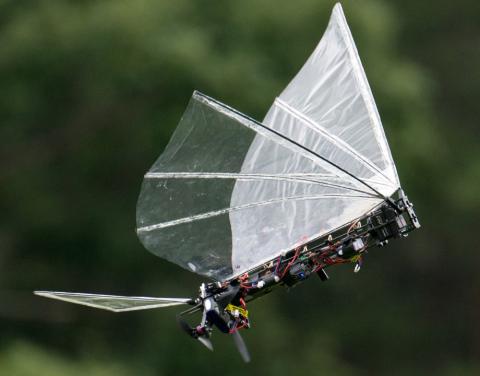Design of a Flapping Wing Robot

Traditional drones, like multi-rotor aerial vehicles, come with inherent drawbacks: they can pose a danger due to their high-speed propellers, and the noise they produce is often stressful for humans [1]. Flapping-wing robots, inspired by birds and insects, address these issues by being safer and more socially accepted. However, the technology is still in its infancy, leaving much room for design innovation.
The goal of this thesis is to design and build a flapping-wing robot tailored to integrate seamlessly with our existing robotics control stack. The project will involve creating a novel mechanical design, developing a control system, and validating the performance through real-world flight tests in a dedicated flight arena.
This thesis provides a unique opportunity to work on cutting-edge bioinspired robotics, contributing to the next generation of safer, quieter aerial vehicles.
- Literature Review:
Study scientific papers on flapping-wing robots to understand the state of the art in design and control. - Mechanical Design:
Develop a mechanical system for the robot, focusing on wing actuation and integration with other components.
Use CAD tools like SolidWorks or Fusion 360 to create detailed designs. - Controller Design and Integration:
Design and implement a control algorithm for stable flight and maneuverability.
Integrate the control system into the robot’s hardware. - Simulation and Testing:
Test the robot in robotics simulators (e.g., Gazebo, Isaac Sim) to refine the design and control system.
Conduct real-world flight tests in a controlled environment to validate the design and performance.
- We do high quality and impactful research in robotics, publishing on the major journals and conferences.
- We often collaborate with other top researchers in europe and worldwide.
- You will have access to a well established laboratory including:
- two flying arenas equipped with motion tracking system, several quadrotors, and a few fully-actuated manipulators,
- one robotic manipulation lab equipped with several robotic arms, like the Franka Emika Panda.
- You will be part of an international and friendly team. We organize several events, from after works, to multi-day lab retreat.
- Regular visits and talks by internationally known researchers from top research labs.
- Excellent written and spoken English skills
- Good experience in C/C++ , ROS, Matlab/Simulink, CAD
- Good experience with numerical trajectory optimization tools for robotics (e.g., use of CaSaDi, Acado, Autodiff, Crocoddyl, etc.)
- Scientific curiosity, large autonomy and ability to work independently
- Experience with robotic systems and/or aerial robots is a plus
Interested candidates are requested to apply via this form. The position will remain open until a satisfactory candidate is found.
In case of positive feedback, you will be contacted. If not positive, you won't hear back.
Applications sent directly by email and not through the web form will not be considered!!





